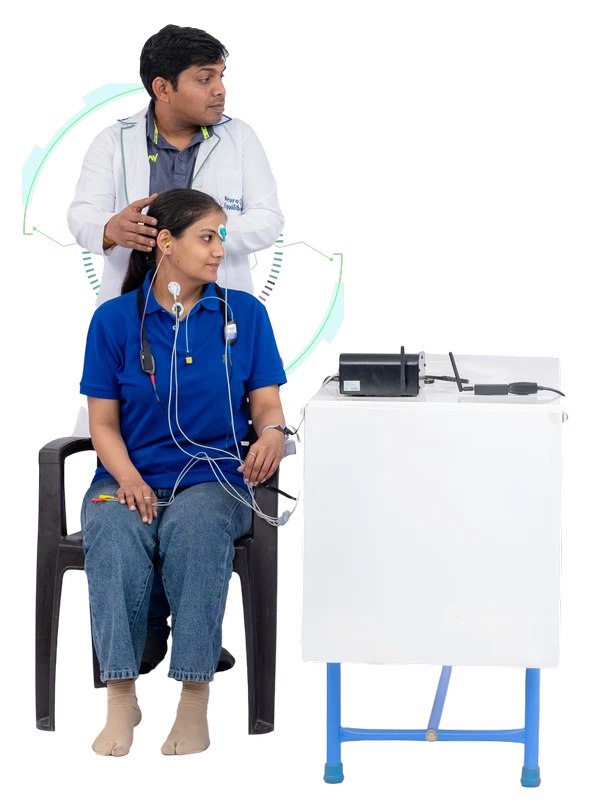






NeuroEquilibrium cVEMP offers a precise and efficient method for assessing otolith and vestibular nerve function, aiding in the diagnosis and management of various vestibular disorders.
A cVEMP test is done to check if your inner ear and a nerve are coordinating properly to keep your balance. While headphones play sounds during the test, stickers on your neck check how your neck muscles react. This way, doctors can find out if the cause of your dizziness could be because of Ménière’s disease or vestibular neuritis.
Before the test, wash off any lotion, makeup, or moisturizer you have put on your neck, chest, or face. Mention to your doctor whether you are using muscle relaxants or if you have a pacemaker. While having the test, you should move your neck in different directions to help get accurate results.
While taking the test, you will lie down and some small stickers, known as electrodes, will be put on your neck, chest, and forehead. You’ll have headphones that send you clicking or beeping sounds to listen to. At this step, you are meant to nod your head a little to get your neck muscles working. Your muscles’ responses to the sound are captured by the test. It is not painful and normally takes less than an hour.
When the cVEMP test is done, you can resume your normal activities right away. There are no harmful results from taking the test. After looking at how your muscles react to the sounds, the specialist will provide your doctor with the results. Your doctor will then explain everything to you in the next visit. They will let you know if the problem is linked to your inner ear. For this reason, your doctor can decide if you need more tests, adjust how you live, or start medications to manage your symptoms.
When the cVEMP test is done, you can resume your normal activities right away. There are no harmful results from taking the test. After looking at how your muscles react to the sounds, the specialist will provide your doctor with the results. Your doctor will then explain everything to you in the next visit. They will let you know if the problem is linked to your inner ear. For this reason, your doctor can decide if you need more tests, adjust your lifestyle, or start medications to manage your symptoms.
If the doctor finds something wrong during the cVEMP test, they will suggest treatments that match the reason. They might prescribe drugs and urge people with Ménière’s disease to eat less salt. You may be given a referral for vestibular rehabilitation therapy, a kind of physical therapy that improves balance. In some cases, more tests are required. A specialist will come up with a treatment plan that fits your health needs and symptoms.
If a balance issue is identified during the cVEMP test, your doctor will recommend treatments that are specific to your condition. This may include medications and lifestyle changes, such as reducing salt intake for individuals with Ménière’s disease. You might also be referred for vestibular rehabilitation therapy, which helps improve balance through targeted exercises. In some cases, further tests may be needed. The treatment plan will be tailored to your symptoms and overall health to help prevent frequent flare-ups of your condition.
Corporate Office:
140, Shrigopal Nagar, Gopalpura Bypass Road, Jaipur 302018, Rajasthan, India
Manufacturing Site:
1st Floor, Plot No.3, Pooja Tower, Muktanand Nagar, Gopal pura Mode, Jaipur, Rajasthan 302018
All rights reserved © 2024 NeuroEquilibrium Diagnostic Systems Pvt Ltd.
Vertigo Clinic in Ujjain | Vertigo Clinic in Barwani | Vertigo Clinic in Patna | Vertigo Clinic in Miraj | Vertigo Clinic in Kolhapur | Vertigo Clinic in Nashik | Vertigo Clinic in Jaysingpur | Vertigo Clinic in Amravati | Vertigo Clinic in Solapur | Vertigo Clinic in Pune | Vertigo Clinic in Aurangabad | Vertigo Clinic in Nagpur | Vertigo Clinic in Sagar | Vertigo Clinic in Indore | Vertigo Clinic in Jabalpur | Vertigo Clinic in Bhopal | Vertigo Clinic in Bilaspur | Vertigo Clinic in Ahmedabad | Vertigo Clinic in Vadodara | Vertigo Clinic in Surat | Vertigo Clinic in Navi Mumbai | Vertigo Clinic in Thane | Vertigo Clinic in Mumbai | Vertigo Clinic in Palghar | Vertigo Clinic in Jaipur | Vertigo Clinic in Sriganganagar | Vertigo Clinic in Alwar | Vertigo Clinic in Kota | Vertigo Clinic in Udaipur | Vertigo Clinic in Lucknow | Vertigo Clinic in Prayagraj | Vertigo Clinic in Varanasi | Vertigo Clinic in Gurgaon | Vertigo Clinic in Dehradun | Vertigo Clinic in Rohtak | Vertigo Clinic in Amritsar | Vertigo Clinic in Ludhiana | Vertigo Clinic in Greater Noida | Vertigo Clinic in Delhi | Vertigo Clinic in Kannur | Vertigo Clinic in Trichur | Vertigo Clinic in Cochin | Vertigo Clinic in Coimbatore | Vertigo Clinic in Tiruppur | Vertigo Clinic in Chennai | Vertigo Clinic in Hosur | Vertigo Clinic in Bangalore | Vertigo Clinic in Mangalore | Vertigo Clinic in Hyderabad | Vertigo Clinic in Sangli